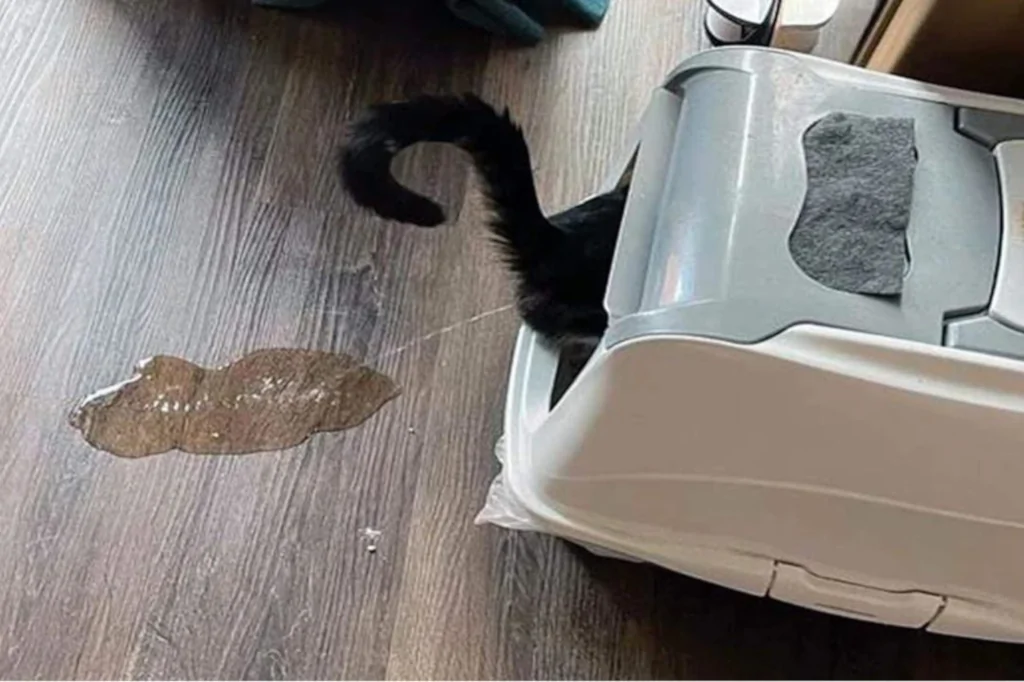Disclosure: We may earn a commission from helpful, relevant links in our content. No cost to you. See our privacy policy.
Ah, the mystifying case of the unused litter box.
You’ve got the perfect spot, the finest kitty litter money can buy, but still, your feline friend stages a protest. It’s frustrating, right? I understand.
It’s like they’re trying to tell you something, but you can’t quite decode the message. It’s a common struggle many cat owners face, but guess what? You’re not alone, and there’s hope!
I’m going to unravel this feline enigma together, from exploring the reasons behind this behavior to offering practical solutions. So, buckle up, it’s time to dive into the world of feline communication, litter box style!

Refusal to Use the Box – What’s the Cause?
First things first, if your cat’s giving the cold shoulder to their litter box, it’s not out of spite or malice – cats simply don’t operate that way.
They’re expressive creatures and this could be their way of communicating discomfort or dissatisfaction.
Possible culprits behind this behavior range from medical issues such as urinary tract infections, to something as simple as a dirty litter box.
Cats are known for their cleanliness and a less-than-spotless litter box might not meet their high standards. If it’s not clean, it’s not appealing.
Another possible reason could be the location of the box. Just as you wouldn’t want your bathroom in the middle of the living room, your cat might be uncomfortable with the litter box’s position. A loud washing machine nearby, high foot traffic, or insufficient privacy can all make your feline feel uneasy.
In some cases, the type of litter could be the issue. Your kitty might not like the scent, texture, or even the dust from the litter. Yes, cats can be that specific!
Don’t worry, we’ll delve into each of these points and more, to help you understand and resolve this little mystery. Let’s demystify this feline behavior together!
Spraying vs. Litter Box Aversion
Spraying and litter box aversion are two distinct behaviors, each with its own set of reasons and solutions. Misunderstanding this can lead to ineffective problem-solving, so let’s break it down.
Spraying is a form of communication in the feline world. It’s when a cat stands up, usually on its hind legs, and ejects urine onto vertical surfaces. Both male and female cats can spray, though it’s more common in unneutered males.
This behavior is often driven by stress, territorial disputes, or a response to changes in the household. If you’ve brought home a new pet or moved to a new house, these changes might trigger spraying behavior in your cat.
Litter Box Aversion, on the other hand, is when your cat consistently eliminates outside the litter box. This could be on horizontal surfaces, like the floor or a pile of laundry.
While medical issues can cause this, it may also result from dissatisfaction with the litter box environment. If the box is too dirty, located in an undesirable place, or filled with a type of litter your cat dislikes, they might decide to do their business elsewhere.
Both issues can be frustrating for cat owners, but understanding the difference is the first step towards a solution.
Suggested reading: Litter-box train your adult cat
Up next, we’ll dive into a toolbox of strategies to tackle these common litter box problems. Hang tight, help is on the way!
Solutions for Common Litter Box Problems
Solution 1: Keep the Litter Box Clean
Cats are meticulous creatures with a keen sense of smell. A dirty litter box can be a major turnoff for them.
Regularly scoop out waste and change the litter completely once a week. If you have multiple cats, you might need to clean it even more frequently.
Consider a litter box with a high-sided design to keep the area around it clean. An excellent option is the Nature’s Miracle High-Sided Litter Box. Its high sides help prevent litter scatter, and it has a non-stick surface for easy cleaning. It’s also spacious, which cats appreciate.
Solution 2: Consider the Box Location
Place the litter box in a quiet, low-traffic area where your cat won’t be disturbed. Avoid placing it near loud appliances, as the noise can scare your cat away.
Ensure there are litter boxes on each floor if you live in a multi-story home to make it easy for your cat to access them.
Solution 3: More Boxes for More Cats
The general rule of thumb is to have one more litter box than the number of cats you have. So if you have two cats, you should have three boxes. This helps to prevent territorial disputes and gives each cat their own space.
Solution 4: Choose the Right Litter
Cats can be picky about the type of litter they prefer. Some might prefer fine-grained, clumping litter, while others might prefer coarser, non-clumping types.
Unscented litter is usually a safe bet, as strong artificial fragrances can be off-putting to cats.

For this, you might want to consider Dr. Elsey’s Unscented Precious Cat Litter. Not only is it unscented, but it also has a dust-free formula and clumps well for easy cleaning.
Try different types and see which one your cat prefers.
Solution 5: Consult a Vet
If your cat continues to avoid the litter box despite your best efforts, it could be a sign of a medical issue, such as a urinary tract infection or kidney disease.
Don’t hesitate to consult your vet if you’re in doubt. They can rule out any health problems and provide further advice tailored to your cat’s situation.
When dealing with litter box issues, you must remain patient as well as consistent. By implementing these solutions, you’re on the right track to resolve your kitty’s litter box woes.

Preventing Issues Before They Start
Prevention is always better than cure, especially when it comes to litter box issues. Here are some proactive steps you can take:
- Start Early. Get your cat accustomed to using a litter box as early as possible. If you’re adopting a kitten or a cat unfamiliar with a litter box, you might need to guide them. Remember, patience and positive reinforcement can go a long way.
- Maintain Cleanliness and Comfort. Regular cleaning, ensuring privacy, and keeping the box away from food and water dishes can create a stress-free space for your cat.
- Monitor Behavior Changes. Be mindful of changes in your cat’s behavior or habits. Any sudden change might indicate a problem. If your cat starts avoiding the litter box or shows signs of discomfort while using it, consult your vet.
- Regular Vet Check-ups. Many medical issues can cause litter box problems, and regular vet check-ups can help catch these problems early.
By following these steps, you can prevent many litter box issues from arising, making life easier for both you and your feline friend.
FAQs
How can I tell if my cat’s litter box issues are due to a medical problem?
Signs of a medical problem can include frequent attempts to urinate with little output, crying out in pain during urination, blood in the urine, or excessive licking of the genital area. If you notice any of these signs, consult your vet immediately.
Can I use deterrents to stop my cat from eliminating outside the litter box?
While deterrents can sometimes work, they should be used with caution. The goal is to make the litter box more appealing, not to scare your cat. Instead, focus on addressing the underlying issue causing the inappropriate elimination.
How can I help my cat adjust to a new litter box location?
Transition slowly by moving the litter box a few feet per day towards the new location. This gradual change can help your cat adjust. Also, ensure the new location is quiet, private, and easy for your cat to access.
Can stress cause my cat to have litter box issues?
Absolutely. Changes in environment, new additions to the household, or other sources of stress can lead to litter box issues. In such cases, identifying and addressing the source of stress can help resolve the problem.
Alex, a passionate animal lover, has experience in training and understanding animal behavior. As a proud pet parent to two dogs and three cats, he founded AnimalReport.net to share insights from animal experts and expand his knowledge of the animal kingdom.




